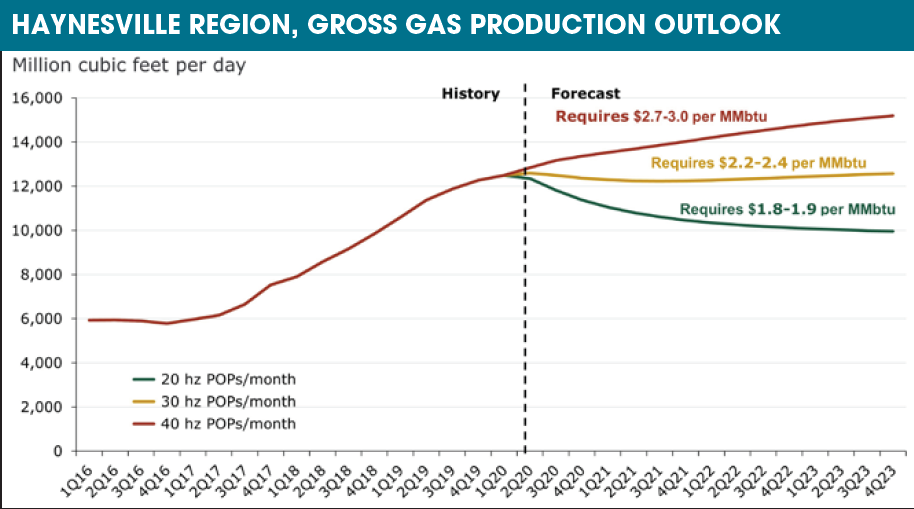
Storm clouds are gathering on the LNG export future that may disrupt the smooth sailing Haynesville Shale. (Source: Shutterstock.com; Hart Energy)
[Editor's note: A version of this story appears in the June 2020 edition of E&P. Subscribe to the magazine here. It was originally published June 1, 2020.]
The Haynesville gas basin, arguably the most important basin for LNG exports in the U.S. due to its proximity to existing and planned terminals, is set for a 20% decline in output toward 2023 if Henry Hub prices average $1.80 to $1.90/MMBtu, according to a Rystad Energy analysis.
Henry Hub prices are currently within the $1.80 to $1.90 range, and if they maintain current levels until 2023, gas production in Haynesville is set for a decline in activity. As a result, Rystad expects only an average of 20 horizontal wells per month will be put on production. Haynesville gross gas output will then fall from 12.5 Bcf/d to 10 Bcf/d throughout 2020-2022, stabilizing in 2023.
In a Henry Hub environment of $2.20 to $2.40, the running rate of activity is at about 30 horizontal wells per month in the medium term. Such an activity level delivers an almost perfect match with maintenance requirements, with production remaining close to 12.5 Bcf/d during 2020 to 2023. Higher gas prices are sufficient to trigger continuous production growth in the Haynesville.
In a $2.70 to $3 Henry Hub environment, the running rate of activity is set to increase to 40 wells per month—sufficient to see another 3 Bcf/d added by the Haynesville before year-end 2023.
“As of today, we have not seen any meaningful production slowdown in Haynesville gas output—yet. With the declining trend, activity is set to fall below maintenance requirements in the next few months. Nevertheless, we should not forget about the likelihood of continuous productivity improvements, which always accompany declining activity due to the renewed focus on the best projects,” said Artem Abramov, Rystad Energy’s head of shale research.
The total number of horizontal spuds per quarter has already declined from about 110 to 120 wells per quarter in the fourth quarter of 2017 to the third quarter of 2019, and to 85 wells in the first quarter of 2020. With the current rig count, the basin will likely be down to 75 horizontal spuds in the second quarter of this year.
The number of wells put on production has lagged behind spuds in 2017 to 2019. But everything changed in the fourth quarter of 2019 to the first quarter of this year, as operators began diving into their drilled but completed inventory (a normal trend when the drilling market begins to decline). In the first quarter, it is estimated that Haynesville operators put 94 horizontal wells on production, but the recent decline in fracking will likely result in about a 15% contraction in activity put on production in the second quarter.
Among all major unconventional oil and gas basins in the U.S., the Haynesville exhibits the highest production contribution from private operators. As of the first quarter, private operators produced 7.2 Bcf/d of gross gas in the region, almost 60% of total output. Private operators also drove nearly all recent growth in the region.

As of the first quarter, short-term growth is probably over for dedicated public operators and supermajors—both groups exhibit little to no growth on a year-over-year basis, with a growing number of operators managing a plateau. In turn, many private operators had a back-loaded growth schedule in 2019, and the group as a whole pushed its year-over-year growth to a record high level of about 1.5 Bcf/d, a level previously achieved in 2018.
Recommended Reading
Kissler: Gas Producers Should Still Hedge on Price
2025-03-27 - Recent price jumps and rising demand don’t negate the need to protect against future drops.
Not Sweating DeepSeek: Exxon, Chevron Plow Ahead on Data Center Power
2025-02-02 - The launch of the energy-efficient DeepSeek chatbot roiled tech and power markets in late January. But supermajors Exxon Mobil and Chevron continue to field intense demand for data-center power supply, driven by AI technology customers.
Buying Time: Continuation Funds Easing Private Equity Exits
2025-01-31 - An emerging option to extend portfolio company deadlines is gaining momentum, eclipsing go-public strategies or M&A.
Stonepeak Backs Longview for Electric Transmission Projects
2025-03-24 - Newly formed Longview Infrastructure will partner with Stonepeak as electric demand increases from data centers and U.S. electrification efforts.
BlackRock CEO: US Headed for More Inflation in Short Term
2025-03-11 - AI is likely to cause a period of deflation, Larry Fink, founder and CEO of the investment giant BlackRock, said at CERAWeek.
Comments
Add new comment
This conversation is moderated according to Hart Energy community rules. Please read the rules before joining the discussion. If you’re experiencing any technical problems, please contact our customer care team.





